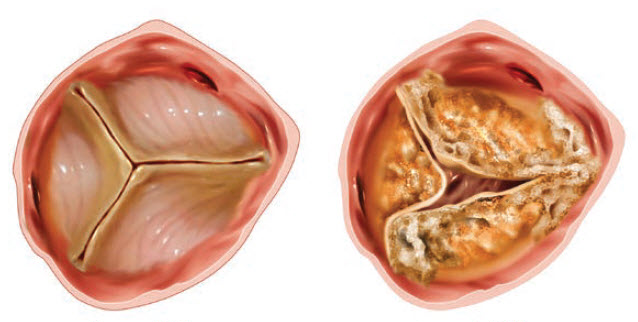What is the Aortic Valve and Its Function
The aortic valve is one of the heart’s four main valves. It sits between the left ventricle and the aorta, allowing oxygen-rich blood to flow from the heart to the rest of the body while preventing it from flowing back into the heart after each heartbeat.
When the aortic valve becomes narrowed or calcified, blood flow from the heart to the body is restricted. Over time, this increases the workload on the heart muscle and can lead to fatigue, shortness of breath, and heart failure if left untreated.

What is Aortic Valve Replacement by Catheter (TAVI)
Aortic valve replacement by catheter, known medically as TAVI (Transcatheter Aortic Valve Implantation), is a modern, minimally invasive procedure used to replace a damaged or narrowed aortic valve without the need for open-heart surgery.
During this procedure, a new artificial valve is inserted through a thin catheter, usually via the femoral artery in the groin or a small incision in the chest, and is positioned inside the diseased valve.
TAVI has revolutionised cardiology as it offers a safer and less invasive alternative for patients who are not suitable candidates for traditional surgery.
When is Aortic Valve Catheter Treatment Needed?
This procedure is typically recommended for patients suffering from severe aortic valve stenosis or calcification, particularly in the following situations:
When open-heart surgery carries a high risk due to advanced age or other medical conditions.
When the patient experiences symptoms such as chest pain, severe fatigue, or shortness of breath.
If there is evidence of heart muscle weakness due to restricted blood flow.
In cases where previously implanted biological valves have failed over time.
Preoperative Preparation
Before undergoing the procedure, patients are required to complete several assessments, including:
CT scan of the chest to evaluate the anatomy of the valve and blood vessels.
Electrocardiogram (ECG) and echocardiography to assess the heart’s function and valve performance.
Blood tests and kidney function tests to ensure the body is ready for the procedure.
Patients are usually asked to fast for several hours before the operation and to inform the doctor about any medications they are currently taking, especially blood thinners.
How the TAVI Procedure is Performed
The procedure starts with local anaesthesia at the catheter insertion site, usually in the groin.
A thin catheter carrying the new valve is carefully guided through the femoral artery to reach the aortic valve.
Using advanced imaging, the cardiologist accurately positions the new valve inside the diseased one.
Once in place, the artificial valve is expanded, replacing the old valve and restoring proper blood flow.
The catheter is then removed, and pressure is applied to prevent bleeding.
The whole process usually takes one to two hours, and patients are monitored closely in the intensive care unit for 24 to 48 hours afterward.
Advantages of the Catheter-Based Approach
No need for open-heart surgery or chest incision.
Less pain and faster recovery.
Shorter hospital stay, typically 2–3 days.
Ideal for elderly patients or those with multiple health issues.
High success rate with minimal complications.
Possible Complications
Although TAVI is considered a very safe procedure, as with any medical intervention, minor complications can occur, such as:
Mild bleeding or bruising at the insertion site.
Temporary irregular heart rhythms.
The need for a pacemaker in some cases.
Mild infection that is easily treated with medication.
Postoperative Care and Recovery
After the procedure, patients are advised to:
Rest for a few days and avoid strenuous activity.
Take prescribed medications regularly, especially anticoagulants.
Attend follow-up appointments to monitor valve function.
Maintain a heart-healthy lifestyle, including a balanced diet and avoiding smoking.
Success Rate of TAVI
The success rate of aortic valve replacement by catheter is very high, exceeding 95% in specialised cardiac centres.
Studies have shown that most patients experience a significant improvement in symptoms and overall quality of life within a short period after the procedure.
This is mainly due to advancements in catheter technology and the increasing expertise of interventional cardiologists.
Is TAVI a Permanent Alternative to Surgery?
In many cases, TAVI is an excellent long-term alternative to surgical valve replacement, especially for elderly patients or those with high surgical risk.
However, for younger patients or those with complex heart conditions, open surgery might still be the more appropriate choice.
The final decision is made by the treating cardiologist based on thorough assessments and individual patient factors.
Conclusion
Aortic valve replacement by catheter (TAVI) represents one of the most significant breakthroughs in modern cardiology.
It offers a safe, precise, and effective treatment option with minimal recovery time compared to open-heart surgery.
Dr Amr Imam, Consultant Cardiologist and Interventional Cardiology Specialist, is one of the leading experts in performing TAVI and other advanced catheter-based heart procedures with exceptional success rates.
Following medical advice and maintaining a healthy lifestyle after the procedure are key to achieving the best long-term results and ensuring heart health for years to come.
